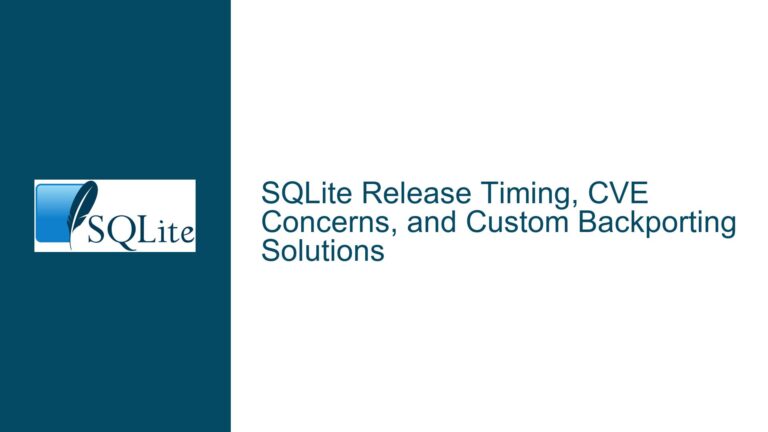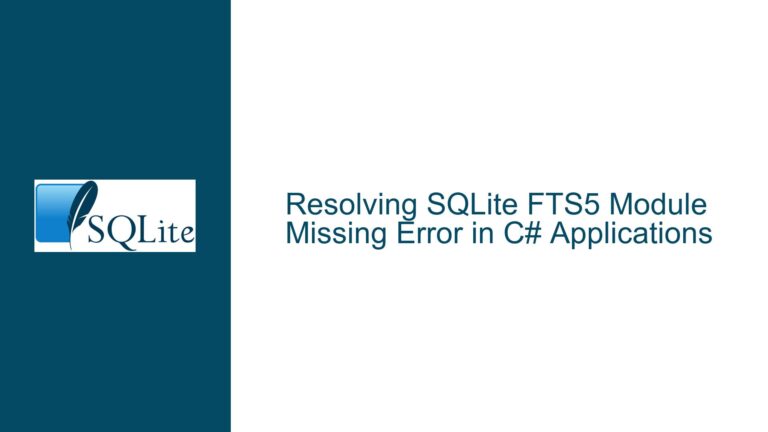Streaming Replication of SQLite WAL to S3: Issues, Causes, and Solutions
SQLite WAL Replication Challenges in Distributed Environments
Streaming replication of SQLite databases, particularly the Write-Ahead Logging (WAL) changes, to cloud storage solutions like Amazon S3, presents a unique set of challenges. SQLite is renowned for its simplicity and lightweight nature, making it a popular choice for embedded systems and applications requiring a local database. However, when integrating SQLite with distributed systems, such as replicating WAL changes to S3, several complexities arise. These include ensuring data consistency, handling concurrent access, managing network latency, and dealing with potential failures during the replication process.
The Write-Ahead Logging (WAL) mechanism in SQLite is designed to improve concurrency by allowing multiple readers and a single writer to operate simultaneously. The WAL file contains changes that have not yet been committed to the main database file. Replicating these changes to a remote storage system like S3 requires careful handling to ensure that the replicated data remains consistent and usable. The primary challenge lies in the fact that SQLite was not originally designed for distributed environments, and thus, its replication mechanisms need to be carefully managed to avoid data corruption or loss.
One of the key issues in streaming replication is ensuring that the WAL changes are captured and transmitted accurately and in the correct order. Any disruption in this process, such as network failures or process crashes, can lead to inconsistencies between the local database and the replicated data on S3. Additionally, the replication tool must handle the locking and checkpointing mechanisms of SQLite correctly to avoid conflicts with the database operations.
Interrupted Replication Processes and Network Latency Issues
The replication of SQLite WAL changes to S3 can be interrupted by various factors, leading to potential data inconsistencies. One of the primary causes of such interruptions is network latency or failures. When replicating data to a remote storage system like S3, the network becomes a critical component of the replication process. Any delay or failure in the network can result in incomplete or out-of-order replication of WAL changes, which can compromise the integrity of the replicated data.
Another significant cause of replication issues is the improper handling of SQLite’s locking and checkpointing mechanisms. SQLite uses a locking mechanism to ensure that only one writer can modify the database at a time, while allowing multiple readers. The checkpointing process is responsible for transferring changes from the WAL file to the main database file. If the replication tool does not correctly handle these mechanisms, it can lead to conflicts between the replication process and the database operations, resulting in data corruption or loss.
Furthermore, the replication tool must be able to handle the case where the local SQLite database is being actively modified while the replication process is ongoing. This requires careful coordination between the replication tool and the SQLite database to ensure that the WAL changes are captured and replicated without interfering with the normal operation of the database. Failure to do so can result in missed WAL changes or inconsistent replication.
Implementing Robust Replication Strategies and Backup Mechanisms
To address the challenges of streaming replication of SQLite WAL changes to S3, it is essential to implement robust replication strategies and backup mechanisms. One of the key strategies is to ensure that the replication tool correctly handles SQLite’s locking and checkpointing mechanisms. This can be achieved by using the SQLite API to acquire the necessary locks and perform checkpoints at appropriate intervals. By doing so, the replication tool can ensure that it does not interfere with the normal operation of the database while capturing and replicating the WAL changes.
Another important strategy is to implement a reliable network communication protocol that can handle network latency and failures. This can be achieved by using techniques such as retries, timeouts, and buffering to ensure that WAL changes are transmitted reliably to S3. Additionally, the replication tool should be designed to handle out-of-order WAL changes and ensure that they are applied in the correct order on the remote storage system.
To further enhance the reliability of the replication process, it is recommended to implement a backup mechanism that periodically creates a snapshot of the local SQLite database and replicates it to S3. This can serve as a fallback in case the replication of WAL changes fails or becomes inconsistent. The backup mechanism should be designed to minimize the impact on the performance of the local database while ensuring that the replicated data remains consistent and usable.
In addition to these strategies, it is important to monitor the replication process and detect any issues as early as possible. This can be achieved by implementing logging and alerting mechanisms that provide visibility into the replication process and notify the administrators of any failures or inconsistencies. By doing so, the administrators can take corrective actions promptly and ensure the integrity of the replicated data.
Finally, it is crucial to thoroughly test the replication tool in various scenarios, including network failures, high load, and concurrent database modifications. This will help identify any potential issues and ensure that the replication tool can handle real-world conditions effectively. By implementing these strategies and mechanisms, it is possible to achieve reliable and consistent replication of SQLite WAL changes to S3, even in distributed environments.
Ensuring Data Consistency and Handling Concurrent Access
Ensuring data consistency during the replication process is paramount, especially when dealing with concurrent access to the SQLite database. SQLite’s WAL mechanism allows multiple readers and a single writer to operate simultaneously, but this concurrency introduces complexities when replicating changes to a remote storage system like S3. The replication tool must be designed to handle these concurrent operations without compromising data integrity.
One approach to ensuring data consistency is to implement a transaction-based replication strategy. In this approach, the replication tool captures and replicates entire transactions rather than individual WAL changes. This ensures that the replicated data on S3 reflects a consistent state of the database, even if multiple transactions are being executed concurrently. By replicating transactions as atomic units, the replication tool can avoid partial or inconsistent updates on the remote storage system.
Another important consideration is the handling of concurrent writes. If multiple processes or threads are writing to the SQLite database simultaneously, the replication tool must ensure that the WAL changes are captured and replicated in the correct order. This can be achieved by using SQLite’s locking mechanism to serialize the writes and ensure that the replication tool captures the changes in the order they were committed. Additionally, the replication tool should be designed to handle conflicts that may arise when multiple writers attempt to modify the same data concurrently.
To further enhance data consistency, it is recommended to implement a versioning mechanism that tracks the state of the replicated data on S3. This can be achieved by associating a version number or timestamp with each replicated transaction or WAL change. By doing so, the replication tool can detect and resolve conflicts that may arise due to concurrent modifications or network delays. The versioning mechanism can also be used to implement a rollback or recovery process in case of replication failures.
In addition to these strategies, it is important to implement a robust error handling and recovery mechanism. The replication tool should be designed to detect and handle errors that may occur during the replication process, such as network failures, storage errors, or data corruption. This can be achieved by implementing retries, fallback mechanisms, and data validation checks. By doing so, the replication tool can ensure that the replicated data remains consistent and usable, even in the face of errors or failures.
Optimizing Performance and Minimizing Latency
Optimizing the performance of the replication process is crucial, especially when dealing with high-throughput applications or large databases. The replication tool must be designed to minimize latency and ensure that the WAL changes are replicated to S3 as quickly as possible. This requires careful consideration of various factors, including network bandwidth, storage performance, and the efficiency of the replication algorithm.
One approach to optimizing performance is to implement a batching mechanism that groups multiple WAL changes together and replicates them in a single operation. This reduces the overhead associated with individual network requests and can significantly improve the throughput of the replication process. The batching mechanism should be designed to balance the trade-off between latency and batch size, ensuring that WAL changes are replicated promptly without overwhelming the network or storage system.
Another important consideration is the use of compression and encryption techniques to reduce the size of the replicated data and protect it during transmission. Compression can significantly reduce the amount of data that needs to be transmitted over the network, thereby improving the performance of the replication process. Encryption, on the other hand, ensures that the replicated data remains secure and protected from unauthorized access. The replication tool should be designed to support both compression and encryption, allowing administrators to configure these options based on their specific requirements.
In addition to these techniques, it is important to optimize the performance of the local SQLite database to ensure that it can handle the additional load imposed by the replication process. This can be achieved by tuning the database configuration, such as adjusting the WAL size, checkpointing frequency, and cache settings. By optimizing the performance of the local database, the replication tool can ensure that it captures and replicates WAL changes efficiently without impacting the overall performance of the application.
Finally, it is crucial to monitor the performance of the replication process and identify any bottlenecks or inefficiencies. This can be achieved by implementing performance monitoring and profiling tools that provide visibility into the replication process and highlight any areas that require optimization. By continuously monitoring and optimizing the performance of the replication process, it is possible to achieve low-latency and high-throughput replication of SQLite WAL changes to S3.
Conclusion
Streaming replication of SQLite WAL changes to S3 presents a unique set of challenges, including ensuring data consistency, handling concurrent access, managing network latency, and dealing with potential failures. By implementing robust replication strategies, backup mechanisms, and performance optimization techniques, it is possible to achieve reliable and consistent replication of SQLite databases in distributed environments. The key to success lies in careful design, thorough testing, and continuous monitoring of the replication process to ensure that it meets the requirements of the application and provides a reliable and scalable solution for replicating SQLite databases to cloud storage systems like S3.






